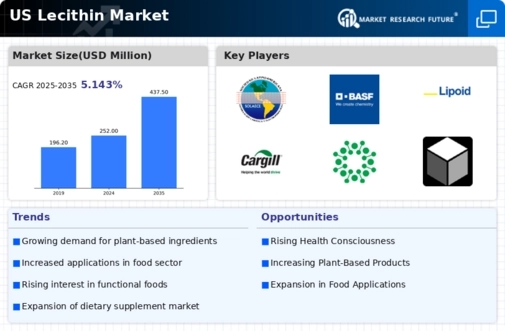Growing Health Consciousness
The increasing awareness of health and wellness among consumers is driving the lecithin market. As individuals seek healthier dietary options, lecithin, known for its emulsifying properties and potential health benefits, is gaining traction. It is often used in food products as a natural additive, appealing to health-conscious consumers. The market data indicates that the demand for lecithin in food applications has risen by approximately 15% over the past year. This trend is likely to continue as more consumers prioritize clean label products, further propelling the lecithin market.
Rising Use in Nutraceuticals
The growing interest in nutraceuticals is a key driver for the lecithin market. Lecithin is recognized for its potential health benefits, including supporting brain health and cholesterol management. As the nutraceutical industry expands, the incorporation of lecithin into dietary supplements is becoming more prevalent. Recent market analysis suggests that the nutraceutical segment could account for up to 25% of the total lecithin market by 2026. This trend indicates a robust opportunity for growth, as consumers increasingly seek products that promote overall well-being.
Expanding Applications in Food Industry
The diversification of applications for lecithin within the food industry is a significant driver for the lecithin market. Lecithin is utilized in a wide range of products, including baked goods, chocolates, and dressings, due to its emulsifying and stabilizing properties. The food sector's continuous innovation and the trend towards convenience foods are likely to enhance the demand for lecithin. Current estimates suggest that the food industry could represent over 60% of the total lecithin market by 2025, highlighting its critical role in food formulation and product development.
Regulatory Support for Natural Additives
Regulatory frameworks in the US are increasingly favoring the use of natural additives, which positively influences the lecithin market. Agencies such as the FDA have recognized lecithin as Generally Recognized As Safe (GRAS), facilitating its use in various food products. This regulatory support encourages manufacturers to incorporate lecithin into their formulations, aligning with consumer preferences for natural ingredients. As a result, the lecithin market is expected to grow steadily, with projections indicating a potential increase of 12% in market value over the next few years.
Technological Advancements in Extraction
Innovations in extraction technologies are significantly impacting the lecithin market. Enhanced methods for extracting lecithin from soybeans and other sources have improved yield and quality, making it more accessible for various applications. For instance, the adoption of cold-press extraction techniques has minimized the degradation of lecithin's beneficial properties. This advancement is expected to boost production efficiency, potentially increasing the market size by 10% in the coming years. As manufacturers adopt these technologies, the lecithin market is likely to experience a surge in demand across multiple sectors.


















Leave a Comment